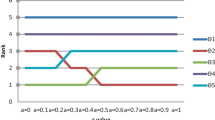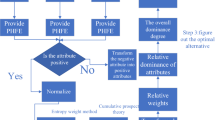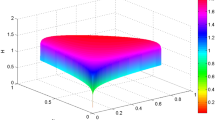Abstract
Picture fuzzy numbers (PFNs) with three degrees of memberships can be used to accurately describe the uncertainty of cognitive information. However, picture fuzzy multi-criteria decision-making (MCDM) methods need to be further studied. This paper describes an extended picture fuzzy multi-objective optimization by ratio analysis and a full multiplicative form (MULTIMOORA) method based on the prospect theory (PT) to handle MCDM. By adopting this process, decision-makers (DMs) can provide fuzzy linguistic terms to evaluate relevant criteria. The evaluation information can be transformed into PFNs based on transformation scales. Then, the corresponding weights of criteria can be calculated according to picture fuzzy entropy. Moreover, the PT, which is considered an important tool for describing the psychological cognition of DMs, can be used to obtain a prospect decision matrix. Here, the MULTIMOORA method, which involves the simultaneous application of the picture fuzzy ratio system, the picture fuzzy reference point, and the picture fuzzy multiplicative form methods, was utilized to determine the final rankings of candidate alternatives. We hence propose an extended picture fuzzy MULTIMOORA method based on the PT, the MULTIMOORA method, and picture fuzzy Dice distance measures, which can be applied to MCDM problems where weight information is completely unknown. The feasibility and validity of the proposed method were verified by applying it to medical institution selection. Sensitivity and comparative analyses demonstrated the superiority of this method compared to the existing ones.













Similar content being viewed by others
References
Parkinson J, Gallegos D, Russell-Bennett R. Transforming beyond self: fluidity of parent identity in family decision-making. J Bus Res. 2016;69(1):110–9.
Xiao YZ, Zhang HS, Basadur TM. Does information sharing always improve team decision making? An examination of the hidden profile condition in new product development. J Bus Res. 2016;69(2):587–95.
Xiao QZ, Shan MY, Gao MY, Xiao XP, Goh M. Parameter optimization for the nonlinear grey Bernoulli model and its application in predicting biomass energy consumption. Appl Soft Comput. 2020;95:106538.
Zadeh LA. Fuzzy sets. Inf Control. 1965;8:338–56.
Atanassov K. Intuitionistic fuzzy sets. Fuzzy Sets Syst. 1986;20:87–96.
Torra V, Narukawa Y. On hesitant fuzzy sets and decision. The 18th IEEE International Conference on Fuzzy Systems, Jeju Island, Korea. 2009:1378–1382.
Liu P, Chen SM, Wang P. Multiple-attribute group decision-making based on q-rung orthopair fuzzy power Maclaurin symmetric mean operators. IEEE Transactions on Systems, Man, and Cybernetics: Systems. 2018;99:1–16.
Liu P, Wang P. Multiple-attribute decision making based on Archimedean Bonferroni operators of q-rung orthopair fuzzy numbers. IEEE Trans Fuzzy Syst. 2019;27(5):834–48.
Liu P, Teng F. Probabilistic linguistic TODIM method for selecting products through online product reviews. Inf Sci. 2019;485:441–55.
Liao H, Tang M, Qin R, Mi XM, Altalhi A, Alshomrani S, Herrera F. Overview of hesitant linguistic preference relations for representing cognitive complex information: where we stand and what is next. Cogn Comput. 2020;12:25–48.
Liu P, Wang P, Pedrycz W (2020) Consistency- and consensus-based group decision-making method with incomplete probabilistic linguistic preference relations. IEEE Trans Fuzzy Syst 2020. https://doi.org/10.1109/TFUZZ.2020.3003501
Rao CJ, Yan BJ. Study on the interactive influence between economic growth and environmental pollution. Environ Sci Pollut Res. 2020;27(31):39442–65.
Rao CJ, He YW, Wang XL. Comprehensive evaluation of non-waste cities based on two-tuple mixed correlation degree. Int J Fuzzy Syst. 2021;23(2):369–91.
Zhang X, Zhang H, Wang J. Discussing incomplete 2-tuple fuzzy linguistic preference relations in multi-granular linguistic MCGDM with unknown weight information. Soft Comput. 2019;23(6):2015–32.
Cuong BC, Kreinovich V. Picture fuzzy sets - a new concept for computational intelligence problems. Proc. of 3rd World Congress on Information and Communication Technologies (WICT). 2013;1–6.
Luo M, Zhang Y. A new similarity measure between picture fuzzy sets and its application. Eng Appl Artif Intell. 2020;96:103956.
Nguyen VD, Nguyen XT. Some measures of picture fuzzy sets and their application in multi-attribute decision making. International Journal of Mathematical Sciences and Computing. 2018;3:23–41.
Peng SM. Study on enterprise risk management assessment based on picture fuzzy multiple attribute decision-making method. J Intell Fuzzy Syst. 2017;33:3451–8.
Peng JJ, Tian C, Zhang WY, Zhang S, Wang JQ. An integrated multi-criteria decision-making framework for sustainable supplier selection under picture fuzzy environment. Technol Econ Dev Econ. 2020;26(3):573–98.
Singh P. Correlation coefficients for picture fuzzy sets. J Intell Fuzzy Syst. 2015;28(2):591–604.
Son LH. Measuring analogousness in picture fuzzy sets: from picture distance measures to picture association measures. Fuzzy Optim Decis Making. 2017;16:359–78.
Thong PH. A novel automatic picture fuzzy clustering method based on particle swarm optimization and picture composite cardinality. Knowl-Based Syst. 2016;109:48–60.
Wei G. Picture fuzzy cross-entropy for multiple attribute decision making problems. J Bus Econ Manag. 2016;17(4):491–502.
Wei G. Picture fuzzy aggregation operators and their application to multiple attribute decision making. J Intell Fuzzy Syst. 2017;33(2):713–24.
Wang C, Zhou X, Tu H, Tao S. Some geometric aggregation operators based on picture fuzzy sets and their application in multiple attribute decision making. Ital J Pure Appl Math. 2017;37:477–92.
Wang L, Peng JJ, Wang J-Q. A multi-criteria decision-making framework for risk ranking of energy performance contracting project under picture fuzzy environment. J Clean Prod. 2018;191:105–18.
Wang L, Zhang HY, Wang JQ, Li L. Picture fuzzy normalized projection-based VIKOR method for the risk evaluation of construction project. Appl Soft Comput. 2018;64:216–26.
Wei G, Alsaadi FE, Hayat T, Alsaed A. Projection models for multiple attribute decision making with picture fuzzy information. Int J Mach Learn Cybern. 2016:1–7.
Wang L, Zhang HY, Wang J-Q, Wu G-F. Picture fuzzy multi-criteria group decision-making method to hotel building energy efficiency retrofit project selection. RAIRO-Operations Research. 2020;54(1):211–29.
Wang L, Wang XK, Peng JJ, Wang JQ. The differences in hotel selection among various types of travellers: a comparative analysis with a useful bounded rationality behavioral decision support model. Tour Manag. 2020b;76:103961.
Ju YB, Ju DW, Gonzalez EDR, Giannakis SM. Study of site selection of electric vehicle charging station based on extended GRP method under picture fuzzy environment. Comput Ind Eng. 2019;135:1271–85.
Wang R, Wang J, Gao H, Wei G. Methods for MADM with picture fuzzy Muirhead mean operators and their application for evaluating the financial investment risk. Symmetry. 2018;11(1):6.
Tian C, Peng JJ, Zhang S, Zhang WY, Wang JQ. Weighted picture fuzzy aggregation operators and their applications to multi-criteria decision-making problems. Comp Ind Eng. 2019;137:106037.
Wei G, Gao H. The generalized Dice similarity measures for picture fuzzy sets and their applications. Informatica. 2018;29:107–24.
Tian C, Peng JJ. An integrated picture fuzzy ANP-TODIM multi-criteria decision-making approach for tourism attraction recommendation. Technol Econ Dev Econ. 2020;26(2):331–54.
Tian C, Peng JJ, Zhang S, Wang JQ, Goh M. A sustainability evaluation framework for WET-PPP projects based on a picture fuzzy similarity-based VIKOR method. J Clean Prod. 2021;289:125130.
Brauers WKM, Zavadskas EK. The MOORA method and its application to privatization in a transition economy. Control Cybern. 2006;35(2):445–69.
Brauers WKM, Zavadskas EK. Project management by MULTIMOORA as an instrument for transition economies. Technol Econ Dev Econ. 2010;16(1):5–24.
Dahooie JH, Zavadskas EK, Firoozfar HR, Vanaki AS. An improved fuzzy MULTIMOORA approach for multi-criteria decision making based on objective weighting method (CCSD) and its application to technological forecasting method selection. Eng Appl Artif Intell. 2019;79:114–28.
Wang WZ, Liu XW, Qin Y. A fuzzy Fine-Kinney-based risk evaluation approach with extended MULTIMOORA method based on Choquet integral. Comput Ind Eng. 2018;125:111–23.
Lin M, Huang C, Xu Z. MULTIMOORA based MCDM model for site selection of car sharing station under picture fuzzy environment. Sustain Cities Soc. 2020;53:101873.
Siksnelyte I, Zavadskas EK, Bausys R, Streimikiene D. Implementation of EU energy policy priorities in the Baltic Sea region countries: sustainability assessment based on neutrosophic MULTIMOORA method. Energy Policy. 2019;125:90–102.
Luo L, Zhang C, Liao H. Distance-based intuitionistic multiplicative MULTIMOORA method integrating a novel weight-determining method for multiple criteria group decision making. Comput Ind Eng. 2019;131:82–98.
Kahneman D, Tversky A. Prospect theory: an analysis of decision under risk. Econometrica. 1979;47(2):263–92.
Nie R, Wang J. Prospect theory-based consistency recovery strategies with multiplicative probabilistic linguistic preference relations in managing group decision making. Arab J Sci Eng. 2020;45:2113–30.
Wu Y, Liao M, Hu M, Lin J, Zhou J, Zhang B, Xu C. A decision framework of low-speed wind farm projects in hilly areas based on DEMATEL-entropy-TODIM method from the sustainability perspective: a case in China. Energy. 2020;213:119014.
Liu P, Shen M, Teng F, Zhu B, Rong L, Geng Y. Double hierarchy hesitant fuzzy linguistic entropy-based TODIM approach using evidential theory. Inf Sci. 2021;547:223–43.
Li M, Li Y, Peng Q, Wang J, Yu C. Evaluating community question-answering websites using interval-valued intuitionistic fuzzy DANP and TODIM methods. Appl Soft Computing. 2021;99:106918.
Krohling RA, Souza TTMD. Combining prospect theory and fuzzy numbers to multi-criteria decision making. Expert Syst Appl. 2012;39(13):11487–93.
Krohling RA, Pacheco AGC, Siviero ALT. IF-TODIM: an intuitionistic fuzzy TODIM to multi-criteria decision making. Knowl-Based Syst. 2013;53(9):142–6.
Qin J, Liu X, Pedrycz W. An extended TODIM multi-criteria group decision making method for green supplier selection in interval type-2 fuzzy environment. Eur J Oper Res. 2017;258(2):626–38.
Tversky A, Kahneman D. Advances in prospect theory: cumulative representation of uncertainty. J Risk Uncertain. 1992;5(4):297–323.
Jana C, Senapati T, Pal M, Yager RR. Picture fuzzy Dombi aggregation operators: application to MADM process. Appl Soft Comput. 2019;74:99–109.
Funding
This work is supported by the Philosophy and Social Science Program in Zhejiang Province, China (No. 21NDJC099YB), the Natural Science Foundation of Zhejiang Province, China (No. LY20G010006), Open Research Projects of Zhejiang Lab (No. 2021KG0AB04), and the National Natural Science Foundation of China (Grant Nos. 71701065, 72171208, and 71771195).
Author information
Authors and Affiliations
Corresponding author
Ethics declarations
All the authors have read and have abided by the statement of ethical standards for manuscripts. And we declare that:
(a) The material has not been published in whole or in part elsewhere;
(b) The paper is not currently being considered for publication elsewhere;
(c) All authors have been personally and actively involved in substantive work leading to the manuscript, and will hold themselves jointly and individually responsible for its content;
(d) Authors whose names appear on the submission have contributed sufficiently to the scientific work and therefore share collective responsibility and accountability for the results;
(e) All sources of funding of all the authors may be relevant, including current funding of posts and funding for the research being reported;
(f) The paper does not contain any studies with human participants or animals performed by any of the authors;
(g) There is no conflict of interest.
Additional information
Publisher's Note
Springer Nature remains neutral with regard to jurisdictional claims in published maps and institutional affiliations.
Rights and permissions
About this article
Cite this article
Tian, C., Peng, Jj., Long, Qq. et al. Extended Picture Fuzzy MULTIMOORA Method Based on Prospect Theory for Medical Institution Selection. Cogn Comput 14, 1446–1463 (2022). https://doi.org/10.1007/s12559-022-10006-6
Received:
Accepted:
Published:
Issue Date:
DOI: https://doi.org/10.1007/s12559-022-10006-6




